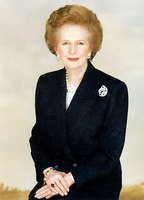Second Thatcher ministry
| Second Thatcher ministry | |
|---|---|
| 86th ministry of the United Kingdom (since 1707) | |
| 1983–1987 | |
 |
|
| Date formed | 9 June 1983 |
| Date dissolved | 11 June 1987 |
| People and organisations | |
| Head of government | Margaret Thatcher |
| Deputy head of government | The Viscount Whitelaw |
| Head of state | Queen Elizabeth II |
| Member party | Conservative Party |
| Status in legislature | Majority |
| Opposition cabinet |
Foot Shadow Cabinet Kinnock Shadow Cabinet |
| Opposition party | Labour Party |
| Opposition leader |
Michael Foot (1983) Neil Kinnock (1983–87) |
| History | |
| Election(s) | 1983 general election |
| Outgoing election | 1987 general election |
| Predecessor | First Thatcher ministry |
| Successor | Third Thatcher ministry |
Margaret Thatcher was Prime Minister of the United Kingdom from 4 May 1979 to 28 November 1990, during which time she led a Conservative government. She was the first woman to hold that office. During her premiership, Thatcher moved to liberalise the British economy through deregulation, privatisation, and the promotion of entrepreneurialism. This article details the Second Thatcher ministry, which existed from 1983 until 1987.
The Conservative government was re-elected in June 1983 with a majority of 144 seats, with Labour in opposition having a mere 209 seats after its worst postwar electoral performance, seeing off a close challenge from the SDP–Liberal Alliance who came close to them on votes though not with seats.
With inflation firmly under control and union reforms contributing towards the lowest level of strikes since the early 1950s, the Tories were now faced with the challenge of reducing unemployment from a record high of 3,200,000.
March 1984 saw the beginning of a miners' strike which would last for 12 months and divide the country as Mrs Thatcher announced extensive pit closures which would ultimately cost thousands of miners their jobs as well, while the remaining pits were set to be privatised in the proposed sell-off of the National Coal Board. Privatisation of utilities and heavy industry was becoming a key symbol of Thatcherism, with the likes of British Telecom also transferring from public to private ownership.
Michael Foot had stepped down as Labour leader after the 1983 general election. The man elected by Labour with the task of getting them back into government was Neil Kinnock. He proved himself as a fierce rival to Thatcher, and more than once during the 1983–87 parliament, the opinion polls showed Labour (and very occasionally the Alliance) in the lead, although a huge swing was required at a general election if the Conservative government was to be ousted.
...
Wikipedia
